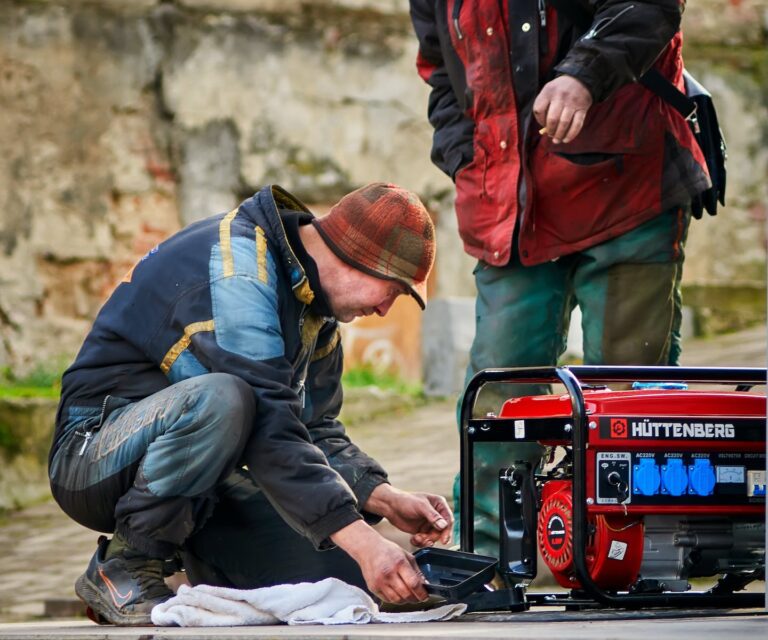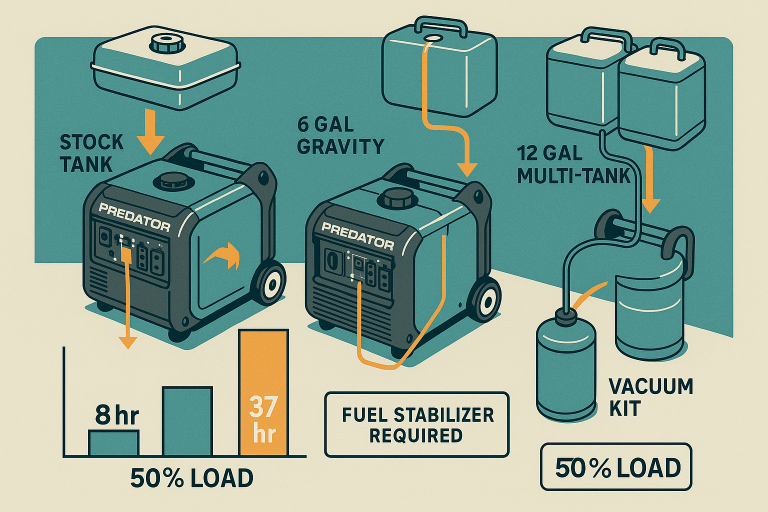How to Connect Two Portable Generators in Series
I’m passionate about DIY projects and always looking for alternative solutions. That’s why I was intrigued by the idea of connecting two portable generators in series.
It’s a method that combines the voltage output, resulting in higher voltage for specific applications. However, it’s important to do it correctly to avoid any risks.
In this article, we’ll explore the step-by-step process, required equipment, and safety measures for safely connecting two portable generators in series.
Key Takeaways
- Verify the voltage and frequency compatibility between the generators and consult the manufacturers or electricians if unsure.
- Use the right size of cables and a series connection kit to match the power output of the generators.
- Operate the generators in well-ventilated areas, away from flammable materials, and in compliance with local codes and regulations.
- Monitor the generators’ temperature, voltage, frequency, and oil pressure, and take immediate action if any issues are noticed to prevent damage or injury.
Compatibility Verification and Precautions
Before connecting the generators in series, it’s important to verify their compatibility and take necessary precautions. Generator maintenance and safety precautions for generator operation are crucial steps to ensure a successful connection.
Firstly, it’s essential to check that the generators have the same voltage and frequency. Reading the manufacturers’ instructions and consulting a qualified electrician, if needed, can help ensure compatibility.
Secondly, it’s important to operate portable generators in well-ventilated areas, away from flammable materials, and in compliance with local codes and regulations.
Lastly, before connecting the generators, carefully read the manufacturers’ instructions and safety precautions. By following these steps, we can protect ourselves and our equipment while connecting portable generators in series.
Connection Process and Equipment
To connect the generators in series, I’ll need a series connection kit. This kit includes the necessary cables and a control panel.
It’s important to select the proper cables and connection kit that match the power output of the generators. Using the right size of cables ensures efficient and safe operation.
Additionally, the control panel in the series connection kit plays a crucial role in load sharing. The load sharing system in the control panel distributes the load evenly between the generators, preventing one generator from being overloaded while the other is underutilized.
This ensures that both generators work together efficiently and prevents any damage or imbalance. Therefore, the importance of a load sharing system can’t be stressed enough when connecting two portable generators in series.
Voltage Output and Applications
With the series connection of generators, the voltage of each generator is added together, resulting in a higher voltage output. This method is useful when a higher voltage is needed, such as for industrial equipment or large appliances. However, it isn’t as common or recommended for residential or small commercial use.
To ensure a successful series connection, it’s important to avoid common mistakes such as mismatched voltage or frequency between the generators. Additionally, parallel connection has advantages over series connection in terms of flexibility and load sharing capability.
It’s important to consult the manufacturers’ instructions and safety precautions for specific voltage requirements and to ensure safe and efficient operation of the connected generators.
Monitoring and Safety Measures
I must keep an eye on the temperature, voltage, frequency, and oil pressure of each generator to ensure safe and efficient operation.
Generator maintenance is crucial to prevent any potential issues. Regularly check the generators for any signs of wear and tear, such as loose connections or leaking oil. Troubleshooting tips are also important to keep in mind.
If there are any abnormal readings or fluctuations in temperature, voltage, frequency, or oil pressure, it’s essential to take immediate action. This can include shutting down the generators, inspecting for any possible malfunctions, and contacting a qualified technician if necessary.
Limitations and Recommendations
Connecting portable generators in series is generally less common and typically recommended for industrial settings where a higher voltage is required. When it comes to the limitations and recommendations for connecting generators in series, it’s important to keep in mind the following safety guidelines and common mistakes:
- Use the right size of cables and series connection kit to match the power output of the generators.
- Consult the manufacturers instructions and safety precautions before connecting the generators.
- Monitor the system to ensure generators are operating within safe limits and load is distributed evenly.
- Be aware of common mistakes such as neglecting to verify compatibility or disregarding safety precautions.
Conclusion
In conclusion, connecting two portable generators in series can be a complex and potentially dangerous process if not done correctly. However, with the right knowledge, equipment, and safety measures, it’s possible to safely and efficiently combine the voltage output of two generators for specific applications.
It’s important to thoroughly understand the process and limitations before attempting this method. By following the outlined steps and recommendations, you can confidently connect two portable generators in series for your DIY projects.


